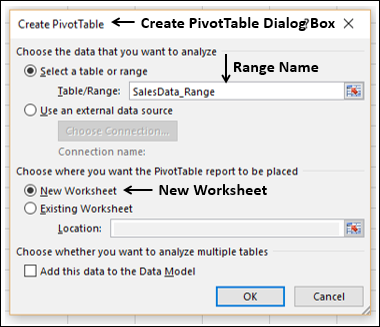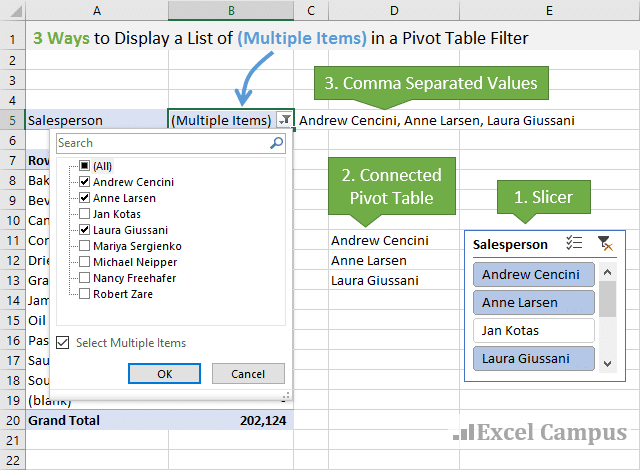Pivot Table Range Names
Usually, things go smoothly when you when you. However, occasionally you might see a pivot table error, Excel Field Names not Valid, if you try to build a new pivot table, or refresh an existing pivot table.Updated Jan. 1, 2019 – macro to help with troubleshooting the pivot table errorPivot Table DataIn the screen shot shown below, there’s a list of sales orders, and we’d like to create a pivot table from that data.Everything looks okay in the source data, but when you try to insert a pivot table, a confusing (and very wide!) error message appears:“The PivotTable field name is not valid. To create a PivotTable report, you must use data that is organized as a list with labeled columns. If you are changing the name of a PivotTable field, you must type a new name for the field.”The message is confusing because the source data is in a list with labeled columns, and you aren’t trying to change the name of any fields. Fix the Field Name ProblemThis error message usually appears because one or more of the heading cells in the source data is blank. Hi-Thanks for your article.I have 50 or more pivot tables in my Excel 2007 file (Windows 7 32 bit) and sometimes will get this error when I refresh all pivot tables but the error message does not tell me which pivot table is experiencing the error.
I’m very confident that it is because of a blank heading (many of my individual worksheet data sources are pulled from external sources and sometimes they do not have headings).Any tips on how to debug the error/file to find out which pivot table(s) is(are) experiencing the error?I end up going through each worksheet by hand to find the blank heading – very inefficient.Thanks so much or any help you can provide.-Michael. I’m in the same boat as Michael, Suzy and Joe.
I have no blank cells in my headers and no merged cells. My source data is correctly assigned as a name, and the dozens of pivot tables that I have use the name as their source data. So I’d imagine that any issues would be either in the source data range or in the named range, both of which look correctly setup. Oh, and another thingthis issue didn’t exist months agoit popped up recently, but there has been no changes to the sheet that contains the source data. I have an update for my last post. I went through my spreadsheet deleting one tab at a time (saved the file as a test file) to see which tab, if any, would make a difference. I was fortunate to find one tab that was causing the issue.

Some of my tabs have multiple pivot tables and some only have one, so I wasn’t sure how this witch hunt was going to turn out.Sometimes I’ll copy a tab with a pivot table because I want the same basic info but I want to do something different with itand I’m too lazy to start a new tab from scratch and configure everything all over again. I believe this is what happened here, except part of the table somehow became severed (and it was in a hidden column which was really weird). So the main table that I was using on this particular tab was functioning fine, but the hidden, severed, table was the culprit! And when I say severed, I guess I mean that there was a remnant of a table, but it only occupied a single column, and when I clicked on it, it did not bring up the pivot table menus off tot he right.So this does not address an easy way of troubleshooting the issue, but maybe this will help others figure something out. I have a large worksheet(A1 thru IA17000)which is plagued with the problem that, whenever one tries to insert or delete a column or row the error message “Excel cannot complete this task with available resources.
Choose less data or close other applications.” reports. The data in this spreadsheet was copied from another workbook’s spreadsheet and pasted into this NEW workbook’s sheet1 as “VALUES” to try to get away from this problem. The problem may be related to the original workbook containing too many worksheetsas daily reports which report in to a worksheet used as a database in the original and likely over loaded workbook. As I say, the original workbook is probably overloaded with too many columns and/or rows or just too much redundant data.
The data, copied to the new workbook’s sheet1 as “VALUES” only, still persists with the error restiction. Can you offer advice as to how I can save the data from the original workbook’s “database” spreadsheet (where all the report data is collected)so that it can be used (additional columns and rows can be inserted, pivot tables built, and etc.). I should mention that another problem, likely an extension of the before error message, is that when I attempt a pivot table in either the original or the new workbook, the error message “The PivotTable field name is not valid. To create a PivotTable report, you must use data that is organized as a list with labeled columns.
If you are changing the name of a PivotTable field, you must type a new name for the field.” reports and no pivot table is possible, so any advice on this one also?Thanks,Tom. My sanity this close to Christmas is most precious.My error was generated because I added a column to a master spreadsheet (5600 rows by 18 columns) which I had already started to split into subsets (5 done, 11 to go) separated by repeated column headers and all range named to make generating and maintaining the pivot tables easy.
It was only when I filtered for an original column header then looked across the sets that I found the gaps for the subsets. Problem was I’d made the change to the top set of headers but not all lower sets of headers.
Doh!Thanks for the pointers. They still work years after the original post.
Please follow the below steps to update pivot table range.1. After you change the data range, click the relative pivot table, and click Option (in Excel 2013, click ANALYZE ) Change Data Source.

See screenshot:2. Then in the pop-up dialog, select the new data range you need to update.
See screenshot:3. Now the pivot table is refreshed.Note: Only rows are added at the bottom of original table data or columns are added at the very right, the pivot table range will update with clicking the Option (or Analyze) Change Data Source.Relative Articles:. More than300 powerful advanced features, designed for1500 work scenarios, increasing productivity by70%, give you more time to take care of family and enjoy life. No longer need memorizing formulas and VBA codes, give your brain a rest from now on.
Pivot Table Range Names 2016

Excel Pivot Table Range
Become an Excel expert in 3 minutes, Complicated and repeated operations can be done in seconds,. Reduce thousands of keyboard & mouse operations every day, say goodbye to occupational diseases now. 110,000 highly effective people and 300+ world-renowned companies' choice. 60-day full features free trial. 60-day money back guarantees. 2 years of free upgrade and support.